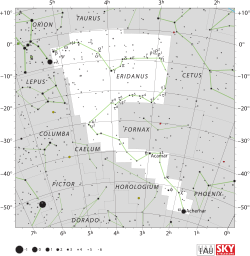Tau1 Eridani
| Tau1 Eridani (τ1) | |
 | |
| Observationsdata Epok: J2000.0 | |
|---|---|
| Stjärnbild | Eridanus |
| Rektascension | 02t 45m 06,18710s[1] |
| Deklination | -18° 34′ 21,2149″[1] |
| Skenbar magnitud () | +4,46[2] |
| Stjärntyp | |
| Spektraltyp | F7 V[3] |
| B–V | +0,48[2] |
| Astrometri | |
| Radialhastighet () | 26,9[4] km/s |
| Egenrörelse (µ) | RA: +334,20[1] mas/år Dek.: +37,19[1] mas/år |
| Parallax () | 70,32 ± 1,83[1] |
| Avstånd | 46 ± 1 lå (14,2 ± 0,4 pc) |
| Absolut magnitud () | +3,68[5] |
| Detaljer | |
| Massa | 1,15[6] M☉ |
| Radie | 1,39[7] R☉ |
| Luminositet | 3,0[7] L☉ |
| Temperatur | 6 231[8] K |
| Metallicitet | 0,02 ± 0,02[a] dex |
| Vinkelhastighet | 28,02[9] km/s |
| Andra beteckningar | |
| 1 Eridani , BD-19° 518, FK5 2075, GJ 111, HD 17206, HIP 12843, HR 818, SAO 11557 [10] | |
Tau1 Eridani (τ1 Eridani, förkortat Tau1 Eri, τ1 Eri) som är stjärnans Bayerbeteckning, är en dubbelstjärna belägen i den västra delen av stjärnbilden Eridanus. Den har en skenbar magnitud på 4,46[2], är synlig för blotta ögat där ljusföroreningar ej förekommer. Baserat på parallaxmätning inom Hipparcosuppdraget på ca 70,3[1] mas, beräknas den befinna sig på ett avstånd på ca 46 ljusår (ca 14 parsek) från solen. För närvarande rör sig stjärnan bort från solen med en radiell hastighet på +26 km/s.[4] För omkring 305 000 år sedan gjorde den perihelionpassage på ett uppskattat avstånd på 30,5 ljusår (9,35 parsek).[11]
Egenskaper[redigera | redigera wikitext]
Tau1 Eridani är en blå till vit stjärna i huvudserien av spektralklass F7 V[3]. Den har en massa som är ca 15[6] procent större än solens massa, en radie som är ca 40[7] procent större än solens och utsänder från dess fotosfär ca 3[7] gånger mera energi än solen vid en effektiv temperatur på ca 6 230[8] K. Den är en spektroskopisk dubbelstjärna med en omloppsperiod på 958 dygn.[12]
Ett måttligt överskott av infraröd strålning observerades för Tau1 Eridani i våglängderna 12 μm, 25 μm, 60 μm och 100 μm av Infrared Astronomical Satellite (IRAS), publicerat 1993.[13] Denna upptäckt tolkades senare som ett tecken på en omgivande stoftskiva med en radie nära 500 AE. Det spekulerades vidare att om stjärnan hade observerats vid längre våglängder var det troligt att stoftskivan skulle ha visat en radie betydligt större än 500 AE.[14]
Senare observationer som gjordes av Spitzer Space Telescope, publicerade 2004, redovisade inget särskilt överskott på infraröd strålning runt stjärnorna inom våglängderna 14-35 μm.[15]
Källor[redigera | redigera wikitext]
- Den här artikeln är helt eller delvis baserad på material från engelskspråkiga Wikipedia, tidigare version.
Referenser[redigera | redigera wikitext]
- ^ [a b c d e f] van Leeuwen, F. (November 2007), "Validation of the new Hipparcos reduction", Astronomy and Astrophysics, 474 (2): 653–664, arXiv:0708.1752 , Bibcode:2007A&A...474..653V, doi:10.1051/0004-6361:20078357.
- ^ [a b c] Mermilliod, J.-C. (1986), "Compilation of Eggen's UBV data, transformed to UBV (unpublished)", Catalogue of Eggen's UBV data, SIMBAD, Bibcode:1986EgUBV........0M.
- ^ [a b] Abt, H. A. (2009). "MK Classifications of Spectroscopic Binaries". The Astrophysical Journal Supplement Series. 180: 117–118. Bibcode:2009ApJS..180..117A. doi:10.1088/0067-0049/180/1/117.
- ^ [a b] Nordström, B.; et al. (2004), "The Geneva-Copenhagen survey of the Solar neighbourhood. Ages, metallicities, and kinematic properties of ~14000 F and G dwarfs", Publications of the Astronomical Society of Australia, 21 (2): 129–133, Bibcode:2004PASA...21..129N, doi:10.1071/AS04013.
- ^ Reiners, A. (January 2006), "Rotation- and temperature-dependence of stellar latitudinal differential rotation", Astronomy and Astrophysics, 446 (1): 267–277, arXiv:astro-ph/0509399 , Bibcode:2006A&A...446..267R, doi:10.1051/0004-6361:20053911.
- ^ [a b] Tokovinin, Andrei; et al. (July 2012), "Revealing Companions to Nearby Stars with Astrometric Acceleration", The Astronomical Journal, 144 (1): 10, arXiv:1204.4206 , Bibcode:2012AJ....144....7T, doi:10.1088/0004-6256/144/1/7, 7.
- ^ [a b c d] https://www.universeguide.com/star/tau1eridani
- ^ [a b] Allende Prieto, C.; et al. (June 2004), "S4N: A spectroscopic survey of stars in the solar neighborhood. The Nearest 15 pc", Astronomy and Astrophysics, 420: 183–205, arXiv:astro-ph/0403108 , Bibcode:2004A&A...420..183A, doi:10.1051/0004-6361:20035801. Vizier catalog entry
- ^ Martínez-Arnáiz, R.; et al. (September 2010), "Chromospheric activity and rotation of FGK stars in the solar vicinity. An estimation of the radial velocity jitter", Astronomy and Astrophysics, 520: A79, arXiv:1002.4391 , Bibcode:2010A&A...520A..79M, doi:10.1051/0004-6361/200913725.
- ^ "* tau01 Eri". SIMBAD. Centre de données astronomiques de Strasbourg. Hämtad 2015-04-15.
- ^ Bailer-Jones, C. A. L. (March 2015), "Close encounters of the stellar kind", Astronomy & Astrophysics, 575: 13, arXiv:1412.3648 , Bibcode:2015A&A...575A..35B, doi:10.1051/0004-6361/201425221, A35.
- ^ Batten, A. H.; et al. (1978), "Seventh catalogue of the orbital elements of spectroscopic binary systems", Publications of the Dominion Astrophysical Observatory Victoria, 15: 121–295;150–151, Bibcode:1978PDAO...15..121B.
- ^ Backman, Dana E; et al. (1993), "Main-sequence stars with circumstellar solid material - The VEGA phenomenon", Protostars and planets III (A93-42937 17-90): 1253–1304, Bibcode:1993prpl.conf.1253B.
- ^ Weintraub, D. A.; et al. (1994). "A reinterpretation of millimeter observations of nearby IRAS excess stars". The Astronomical Journal. 108: 701. Bibcode:1994AJ....108..701W. doi:10.1086/117107.
- ^ Jura, M.; et al. (2004). "Mid‐Infrared Spectra of Dust Debris around Main‐Sequence Stars". The Astrophysical Journal Supplement Series. 154: 453–457. arXiv:astro-ph/0405632 . Bibcode:2004ApJS..154..453J. doi:10.1086/422975.





